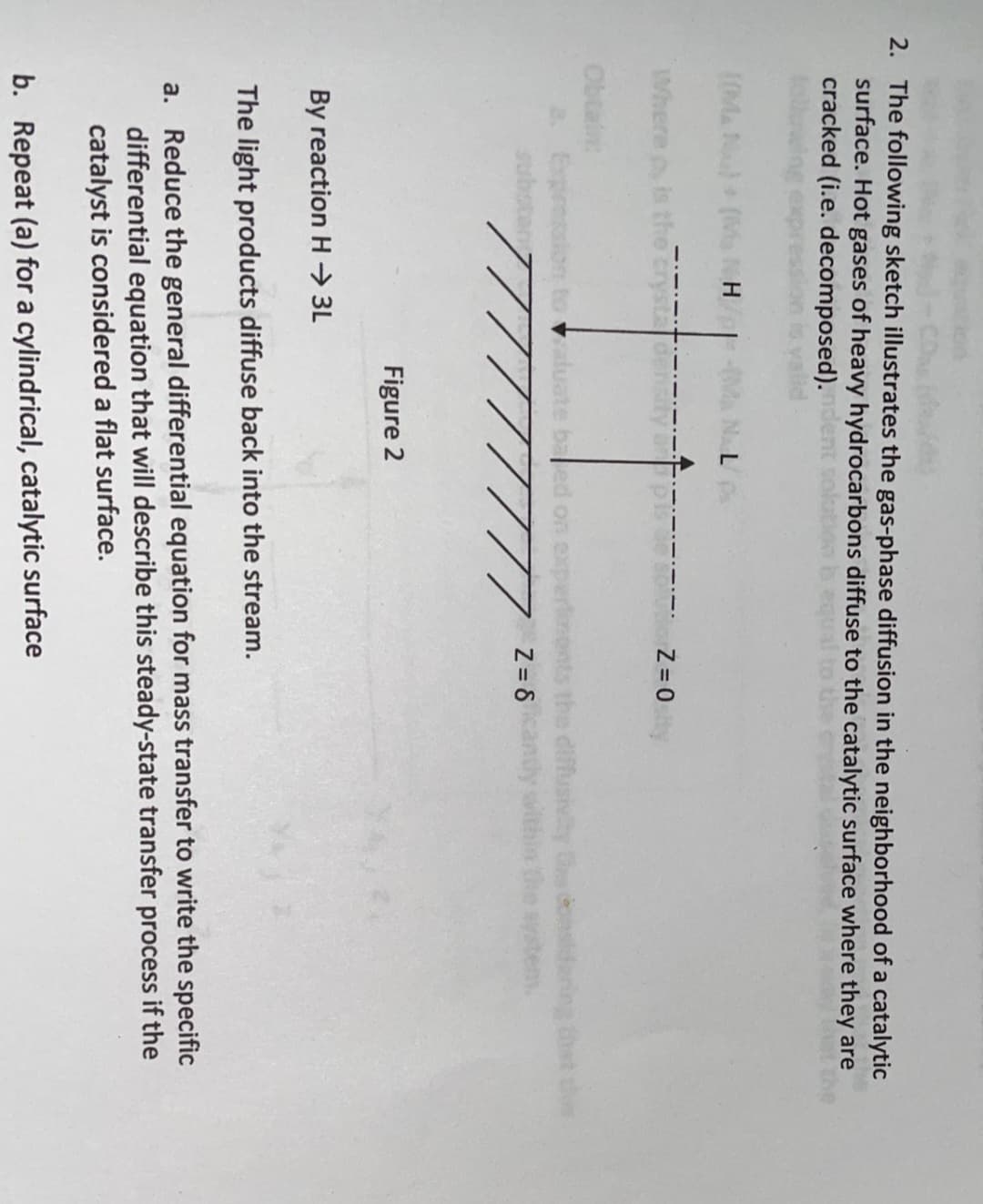2. The following sketch illustrates the gas-phase diffusion in the neighborhood of a catalytic surface. Hot gases of heavy hydrocarbons diffuse to the catalytic surface where they are cracked (i.e. decomposed). LMA N NL P H Where p is the crysta Z = 0 Obtain a. Expresalon sub valuate baled on exp sivity Gsdering thet ths Z = 8 Figure 2 By reaction H → 3L The light products diffuse back into the stream. a. Reduce the general differential equation for mass transfer to write the specific differential equation that will describe this steady-state transfer process if the catalyst is considered a flat surface. b. Repeat (a) for a cylindrical, catalytic surface
2. The following sketch illustrates the gas-phase diffusion in the neighborhood of a catalytic surface. Hot gases of heavy hydrocarbons diffuse to the catalytic surface where they are cracked (i.e. decomposed). LMA N NL P H Where p is the crysta Z = 0 Obtain a. Expresalon sub valuate baled on exp sivity Gsdering thet ths Z = 8 Figure 2 By reaction H → 3L The light products diffuse back into the stream. a. Reduce the general differential equation for mass transfer to write the specific differential equation that will describe this steady-state transfer process if the catalyst is considered a flat surface. b. Repeat (a) for a cylindrical, catalytic surface
Introduction to Chemical Engineering Thermodynamics
8th Edition
ISBN:9781259696527
Author:J.M. Smith Termodinamica en ingenieria quimica, Hendrick C Van Ness, Michael Abbott, Mark Swihart
Publisher:J.M. Smith Termodinamica en ingenieria quimica, Hendrick C Van Ness, Michael Abbott, Mark Swihart
Chapter1: Introduction
Section: Chapter Questions
Problem 1.1P
Related questions
Question
100%
what are the initial conditions and the boundary conditions for the diagram in this picture?

Transcribed Image Text:2. The following sketch illustrates the gas-phase diffusion in the neighborhood of a catalytic
surface. Hot gases of heavy hydrocarbons diffuse to the catalytic surface where they are
cracked (i.e. decomposed).
L0MAN(Ma NH
NAL
Where p is
Obtain
a. Expresal
diffusivty G nsdaring thet this
andy within the system
Valua
baled on
Z = 8
Figure 2
By reaction H → 3L
The light products diffuse back into the stream.
a. Reduce the general differential equation for mass transfer to write the specific
differential equation that will describe this steady-state transfer process if the
catalyst is considered a flat surface.
b. Repeat (a) for a cylindrical, catalytic surface
Expert Solution
This question has been solved!
Explore an expertly crafted, step-by-step solution for a thorough understanding of key concepts.
This is a popular solution!
Trending now
This is a popular solution!
Step by step
Solved in 4 steps with 4 images

Recommended textbooks for you

Introduction to Chemical Engineering Thermodynami…
Chemical Engineering
ISBN:
9781259696527
Author:
J.M. Smith Termodinamica en ingenieria quimica, Hendrick C Van Ness, Michael Abbott, Mark Swihart
Publisher:
McGraw-Hill Education

Elementary Principles of Chemical Processes, Bind…
Chemical Engineering
ISBN:
9781118431221
Author:
Richard M. Felder, Ronald W. Rousseau, Lisa G. Bullard
Publisher:
WILEY

Elements of Chemical Reaction Engineering (5th Ed…
Chemical Engineering
ISBN:
9780133887518
Author:
H. Scott Fogler
Publisher:
Prentice Hall

Introduction to Chemical Engineering Thermodynami…
Chemical Engineering
ISBN:
9781259696527
Author:
J.M. Smith Termodinamica en ingenieria quimica, Hendrick C Van Ness, Michael Abbott, Mark Swihart
Publisher:
McGraw-Hill Education

Elementary Principles of Chemical Processes, Bind…
Chemical Engineering
ISBN:
9781118431221
Author:
Richard M. Felder, Ronald W. Rousseau, Lisa G. Bullard
Publisher:
WILEY

Elements of Chemical Reaction Engineering (5th Ed…
Chemical Engineering
ISBN:
9780133887518
Author:
H. Scott Fogler
Publisher:
Prentice Hall


Industrial Plastics: Theory and Applications
Chemical Engineering
ISBN:
9781285061238
Author:
Lokensgard, Erik
Publisher:
Delmar Cengage Learning

Unit Operations of Chemical Engineering
Chemical Engineering
ISBN:
9780072848236
Author:
Warren McCabe, Julian C. Smith, Peter Harriott
Publisher:
McGraw-Hill Companies, The